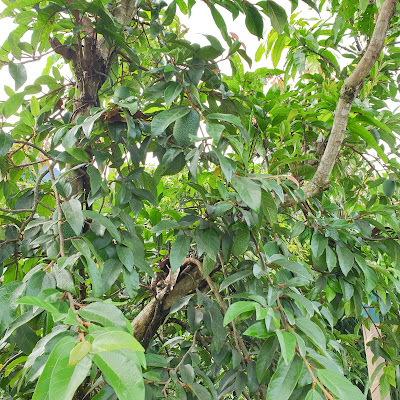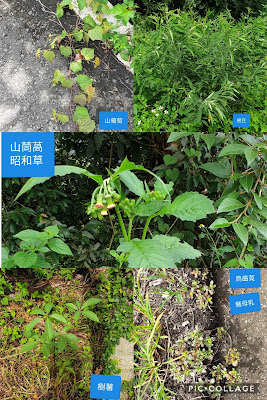COCOA and NAMASIA EXPLORE - PART II
 |
| @ Makatao 馬卡道族 Folk Art Museum Taishan 泰山 Elementary, Gaoshu 高樹 Township, Pingtung Mosaic Wall of John Thomson photography Far-East collection |
 |
@Karuvekuv. Autumn Moon's Shop 秋月之家. View from the gents.
On clear day, Xiaoliuqiu a small island located off the coast of Kaohsiung City is visible at far left.
|
 |
| 姊妹の 家 Sisters' Home Entrance |
@ 大路關 Dalukuan, Gaoshu Township, Pintung
A popular Hakka roadside eatery. Cooked on a popular stove (I call it Dutch Stove, btw) used in Taiwanese traditional kitchen before 1980s, especially South of Taipei.
A couple of minutes' walk to the left is the 'Lion Number Three' of the Famous Hakka STONE LIONS.
Hakka people began to develop this area, said more than 200 years ago, and set up the first stone lion. Hakka believe stone lions have supernatural power, exorcise evil spirits and shielded villages from sudden, strong mountain and valley winds. Additional two lion stones were made during Japanese rule. The 'cute' style maybe rare and the three huge lion stones witnessed the development of Dalukuan and historical vicissitudes.
SCRAP METAL YARD ARTIST: Cheng Yang-Cheng 鄭陽晟
 |
| @Taishan Village, Gaoshu Township, Pintung County |
 |
| Dog house!! |
I HAVE NOT SEEN A PLACE LIKE THIS and I gasped in amazement and admiration - the porch of the elevated house can be pulled up and shut the house into a typhoon shelter!
Ahanah told me Cheng is quite well-known in the region, an artist and culture & heritage activist. Listening and chatting to Cheng, his passion and knowledge of what he does came across in abundance.
A contemporary Paiwan artist 達比烏蘭‧古勒勒 Tapiwulan Kulele in 1998 discovered this 'Treasure House'. The chancing rolled into a unique friendship and ideal working companionship.
 |
| http://kulele-studio.blogspot.com/2011/02/blog-post.html |
Cheng's workshop provides a space for blending indigenous and Han cultures and allow art to develop and create without boundaries. He offers a wide range of professional metalwork services and shares expertise to individual artists and companies.
" I used to run a coffee shop along side my business, now I simply do not have time, but when friends came by, I may offer a good cuppa".
IN SEARCH OF MAKATAO IDENTITY -
reporter. Taipei Times.
"Makatao villages in Pingtung
County concluded their annual Night Festival yesterday, as local government
officials joined the Makatao Aboriginal community to review cultural
revitalization policies and other government programs outlined for the
community over the coming years.
The festival, which took
place this weekend at Laopi Village (老埤) in Pingtung County’s Neipu
Township (內埔),
is one of the three main annual cultural events of the county’s Makatao people,
who are one of 10 officially recognized Pingpu, or lowlands, Aboriginal groups
in Taiwan.
“We had over 300 Pingpu clan
relatives and friends, mostly from southern Taiwan, coming in to attend this
festival,” Laopi Village Elder Pan An-chuan (潘安全) said. “It is an important
occasion for us to get together, to thank the deities who provided guidance,
protection and a good harvest this year, and also to celebrate our cultural
heritage.”
Pan said the traditional
worship rituals and activities were centered on the village’s Laotsu Temple,
where gatherers pay respects to Makatao deities through offerings of pork,
grains, rice wine, betel nuts and fruits, as well as by performing a special
dance known as Tioh-hi.
The dance is performed by
women from the Makatao community and led by female shamans.
A key supporter of the
revitalization of Makatao traditional festivals is Pingtung County Cultural
Affairs Department Director Wu Chin-fa (吳錦發), who has pushed for financial
backing for such programs.
“Household registration data
from 1909, during the Japanese colonial era, show that Laopi Village had 1,186
residents listed as ‘plains Aborigines,’” Wu said in a speech at the festival.
“This was a vibrant Makatao
community and a cultural center in the county,” he said. “It has remained so up
to this day, but work is needed to preserve and pass on the heritage of the
community by Makatao elders, community leaders and cultural researchers.”
Wu said that since Pingtung
County Commissioner Pan Men-an (潘孟安) took office in 2014, programs for
Makatao cultural revitalization have been among the county’s priorities, along
with funding for local schools to teach students about the history and heritage
of Makatao people.
Pan Yen-pao (潘燕寶), who
heads local Makatao culture working groups, said that this year’s event
included an exhibition of old photographs and documents about the Makatao
community that showed people’s activities through the generations, along with a
presentation of traditional local arts and crafts.
“The event is a good way to
educate young people about the traditions and customs of the Makatao community.
It is important for people to recognize their own cultural heritage and
identify themselves as Makatao people,” he said.
Wu and community elders at
the event also invited people to participate in two other upcoming Makatao
festivals in Pingtung, the Ganabo Night Festival in Gaoshu Township (高樹), which will be held overnight from Jan. 1 to Jan. 2,
and the Gabulong Night Festival in Wanluan Township (萬巒), which is scheduled for March 2"In some interviews, Cheng whose family have been living in Taishan village Gaoshu Township for generations, revealed that he had no reason to doubt his identity as a Pinpu boy (Plains indigenous peoples) until in 1995, at the annual Night Festival reported above by Jason Pan of Taipeitimes, recollecting memories of 'different' languages senior family members spoke to communicate among one another, "it suddenly strikes me that I have no idea who I am, what my identity is". He since threw himself into researching about Makatao peoples and cultures and today thrives in advocating Makatao heritage revival and preservation.
 |
| Two of the 'pets' Cheng kept. The larger one he reckons at least 70 years old. |
 |
| No surprise of random visitor |
NAMASIA 那瑪夏 Kaohsiung -
SISTER'S HOME 姊妹の家
Environmental-friendly Indulgence
We first stopped at Sister's restaurant 姊妹小吃 to meet and collect one of the Bunun 布農 twins Abas before heading to the final destination Sister's Home - a Campsite. And here is when I noticed, muntjac and macaque skull appeared proud display of almost every indigenous household. We had for afternoon snack a plate of stir-fry muntjac. Farmed muntjac meat has always been legal, but hunting has only been legal about a year.
She pointed to the painting on the wall and around and said they were done by her artist sister Ebu now living in Cambridge, UK. That's a surprise, as I have heard of Ebu but did not know they were sisters.
We arrived late afternoon and it was raining, the other twin Alas, wife of Rich the veteran Canadian photographer, welcomed and took us to our rooms before quickly showed me around the site which is only partially complete but an outdoor kitchen and sanitary facilities in order.
 |
| Pre-meal drink: peach and plum cider, fruits picked from garden slightly alcoholic and very refreshing |
 |
| Luxury of three meats - mackerel mixed with 刺葱 tana (alianthus-like prickly ash), wild boar, and roast chicken |
 |
| 刺葱 tana (alianthus-like prickly ash leaves) from the garden |
 |
Crunchy salad with 山苦瓜 Kakorot/Balsampear - size of cherry tomato.
Tossed with extract olive oil brought from Ebu - sister in Cambridge |
 |
| Drinking homemade rice wine the traditional way - in bamboo cup for its natural fragrance GOOD MORNING! Clear sunny day and I was able to enjoy nature's bounty, guided first by Abas, and a more thorough extensive walk by Ahanah. |
 |
| First Generation 'Mango and Aiyu Fig Companion Planting' |
 |
Top: Second Generation . Bottom: Third Generation
|
MANGO-AIYU FIG COMPANION PLANTING: Abas made a point of introducing me this method I would never have noticed! She first mentioned it in yesterday's cloudy and wet afternoon, I woke up and made sure this was the priority and asked her again in the first instance. These were just outside their campsite entrance and belonged to another family who live in the village down the mountain.
ACCORDING TO ABAS - Mango tree root grows deep and absorbs water which nourish what grows close to it. Of course, it is also an ideal support for a climbing fig.
FIRST GENERATION means the 'older' generation traditional method - both mango and aiyu fig roots are planted deep into soil and the result is a 'marriage' of the two trees.
SECOND GENERATION IS 10 YEARS OLDER THAN THE THIRD of the above photo. The younger and modern generation do not have patience, she says, and they grow aiyu fig on stone pole and wrap it up for some 10 years before tie to the supporting mango tree.
 |
| Marriage of Mango and Aiyu |
 |
| Jinhuang Mango - one of the most popular Taiwan cultivates |
 |
| It is wonderful feeling to see a hill of well looked-after mango trees! |
AIRPLANE-GREEN 山茼蒿。飛機草。昭和草 garland chrysanthemum (To be clear, its English name I DON'T KNOW. Just what I found online. Several indigenous peoples have it in their vocabulary shown below)
 |
| Abas took me to collect 'taulu' (Bunun word for the green) |
It is also called airplane-green or Shōwa -green. The tale goes during Shōwa rules in Taiwan (1895-1945) , the emperor ordered airplanes flying over the island and scattered 'taulu' seeds - to feed Japanese soldiers...
In the heat of promoting this green, you will hear the tale told many times by different peoples all over Taiwan.
I, however, think it's marketing storytelling. I asked Abas when did she and family start eating this green, did they at her childhood, or did she know her parents did? She denied and said it was only recent... this green (weed) was used to feed chicken, we don't eat it. Indigenous peoples don't like eating greens, we like meat.
Would Emperor Shōwa feed his soldiers weeds that no Taiwanese ate but chicken? Possible, but unlikely.
After we returned, Abas and Alas gave me a bag of nature's bounties all from their garden and on the roadside - before Ahanah - an expert of sourcing nature's ingredients took me on an educational walk of the neighborhood.
So grateful to Ahanah's kindness and generosity in taking time explain and share expertise!
Noteworthy includes:
大花咸豊草 Bidens Alba - used to make Taiwanese herbal tea (qīngcǎo chá) 青草茶
黃荊 Negundo Chastetree - used in dye for food and fabric. And Ahanah told me what Hakka use to make 客家鹼粽 Hakka alkaline zongzi.
樹薯 Cassava plant - tapioca for Pearl Bubble Tea
假酸槳 Trichodesma Calycosumsuan editable leave to make the Paiwan delicacy cinavu
樹豆 Pigeon Pea, Cordia Drupes - in Hualien’s Guangfu Township, there is a place whose name is derived from vataan, the Amis word for this kind of pea.
龍葵 Black Nightshade - known to cure hangover among some indigenous peoples
文定果 Muntingia /Fake South American Cherry. Interesting fruit! It tastes exactly like Taiwanese 冬瓜茶 (sweetened) winter melon tea!
Upon returning to the campsite, while the sisters preparing breakfast, Rich showed me around and talked about the construction side of things, there are still plenty to work on but seems progressing surely and slowly.
LOVELY SUNNY COLORFUL BREAKFAST!
 |
For those interested in Sisters' home campsite, contact Alas/Abas on 0912 765817. Mandarin speaker but English speaking niece might be around.
PART I https://katyhuiwenhung.blogspot.com/2019/08/cocoa-and-namasia-explore-part-i.htm

































Comments
Post a Comment